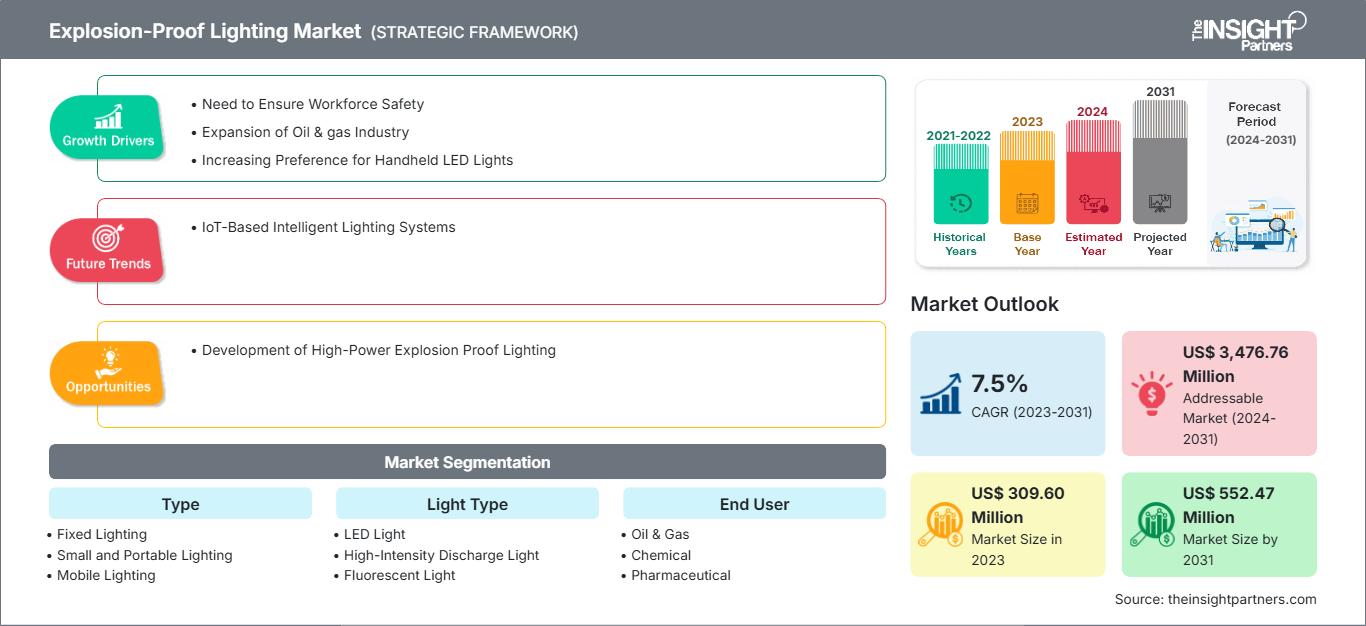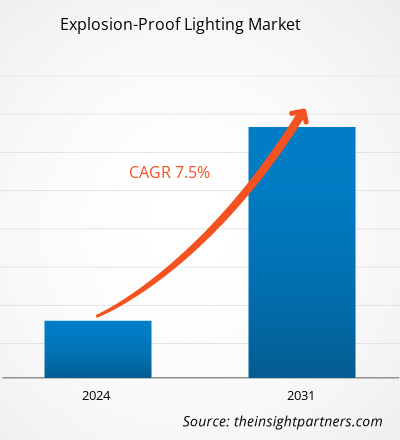Der Markt für explosionsgeschützte Beleuchtung soll von 309,60 Millionen US-Dollar im Jahr 2023 auf 552,47 Millionen US-Dollar im Jahr 2031 anwachsen. Für den Zeitraum 2023–2031 wird ein durchschnittliches jährliches Wachstum von 7,5 % erwartet. IoT-basierte intelligente Beleuchtungssysteme werden in den kommenden Jahren voraussichtlich Trends auf dem Markt setzen.
Marktanalyse für explosionsgeschützte Beleuchtung
Arbeitssicherheit und die ordnungsgemäße Instandhaltung von Gefahrenbereichen in Industrie und Gewerbe haben die Entwicklung und das Wachstum von explosionsgeschützten Geräten wie Beleuchtung vorangetrieben. Derzeit wird das Marktwachstum von Sektoren wie Öl & Gas, Chemie und Energie getrieben. Bestimmte Normen für die Sicherheit in Gefahrenbereichen dieser Sektoren zwingen diese Sektoren dazu, mehr zertifizierte Produkte zu installieren.
Marktübersicht für explosionsgeschützte Beleuchtung
Gefährliche Ereignisse in verschiedenen Branchen können durch die Umsetzung bewährter Verfahren leicht bewältigt werden. Für die Zertifizierung von Geräten für den Einsatz in explosionsgefährdeten Bereichen sind verschiedene Organisationen zuständig. In Nordamerika beispielsweise sind es Underwriters Laboratories (UL) und Factory Mutual (FM), die für die Normen, Prüfungen und Zertifizierungen zuständig sind, während in Kanada die Canadian Standard Association (CSA) die Zulassungen erteilt. In Europa bieten die Organisationen ATEX (Equipment for Potentially Explosive Atmospheres) und die Internationale Elektrotechnische Kommission (IEC) weltweit anerkannte Normen an. Diese Organisationen wie UL, FM und CSA führen ihre Prüfungen nicht selbst durch. Sie beauftragen jedoch Stellen mit der Durchführung der Prüfungen, um die von ihnen festgelegten Normen zu erfüllen. Mehrere nordamerikanische Unternehmen zertifizieren ihre Produkte auch nach IEC- bzw. ATEX-Normen, um sie international zu vertreiben. Die von diesen Organisationen angebotenen Zertifizierungen unterscheiden sich jedoch erheblich.
Passen Sie diesen Bericht Ihren Anforderungen an
Sie erhalten kostenlos Anpassungen an jedem Bericht, einschließlich Teilen dieses Berichts oder einer Analyse auf Länderebene, eines Excel-Datenpakets sowie tolle Angebote und Rabatte für Start-ups und Universitäten.
Markt für explosionsgeschützte Beleuchtung: Strategische Einblicke

- Holen Sie sich die wichtigsten Markttrends aus diesem Bericht.Dieses KOSTENLOSE Beispiel umfasst Datenanalysen, die von Markttrends bis hin zu Schätzungen und Prognosen reichen.
Sie erhalten kostenlos Anpassungen an jedem Bericht, einschließlich Teilen dieses Berichts oder einer Analyse auf Länderebene, eines Excel-Datenpakets sowie tolle Angebote und Rabatte für Start-ups und Universitäten.
Markt für explosionsgeschützte Beleuchtung: Strategische Einblicke

- Holen Sie sich die wichtigsten Markttrends aus diesem Bericht.Dieses KOSTENLOSE Beispiel umfasst Datenanalysen, die von Markttrends bis hin zu Schätzungen und Prognosen reichen.
Markttreiber und -chancen für explosionsgeschützte Beleuchtung
Expansion der Öl- und Gasindustrie
Die Öl- und Gasindustrie spielt eine wichtige Rolle beim wirtschaftlichen Wandel verschiedener Länder. Auf die Branche entfällt der größte Anteil des weltweiten Verbrauchs von Energieressourcen. Erdgas wird in den kommenden Jahren voraussichtlich einer der am schnellsten wachsenden fossilen Brennstoffe sein. Viele Länder steigern ihre Ölproduktionskapazitäten, um ihren nationalen Energiebedarf zu decken. Laut der Internationalen Energieagentur (IEA) wird die weltweite Ölnachfrage zwischen 2022 und 2028 voraussichtlich um 6 % steigen. Ein erheblicher Bedarf kommt aus der Chemie-, Energie-, Strom-, Luftfahrt- und Petrochemieindustrie. Bis 2028 wird der weltweite Bedarf voraussichtlich 105,7 Millionen Barrel pro Tag erreichen. Ein schnell steigender Ölbedarf in verschiedenen Branchen fördert die Öl- und Gasindustrie. Akteure der Gasindustrie müssen ihre Kapazitäten durch Anlagenerweiterungsstrategien steigern, wodurch explosionsgeschützte Geräte wie Beleuchtung erforderlich werden, um den Anlagenbetrieb effizient überwachen und steuern und gleichzeitig die Sicherheit der Arbeiter erhöhen zu können.
Laut dem im November 2023 veröffentlichten Bericht von Urwald eV meldeten 384 Unternehmen weltweit im Zeitraum 2021–2023 durchschnittliche Kapitalausgaben von mehr als 10 Millionen US-Dollar für Öl- und Gasexplorationsaktivitäten. Die sieben Unternehmen mit den höchsten Investitionen in die Öl- und Gasexploration waren China National Petroleum Corporation (5,9 Milliarden US-Dollar), China National Offshore Oil Corporation (3,2 Milliarden US-Dollar), Saudi Aramco (2,8 Milliarden US-Dollar), Pemex (2,6 Milliarden US-Dollar), Sinopec Group (2,4 Milliarden US-Dollar), Pioneer Natural Resources (2,1 Milliarden US-Dollar) und Shell plc (2,0 Milliarden US-Dollar). Diese Investitionen ermöglichen ihnen die Einführung technologisch fortschrittlicher, smarter und intelligenter explosionsgeschützter Beleuchtungssysteme, um die Sichtbarkeit der Arbeiter zu verbessern und sie vor unvorhergesehenen Vorfällen zu schützen. Somit treibt die weltweit expandierende Öl- und Gasindustrie das Wachstum des Marktes für explosionsgeschützte Beleuchtung voran.
Entwicklung von explosionsgeschützter Hochleistungsbeleuchtung
Explosionsgeschützte Beleuchtung wird hauptsächlich unter gefährlichen und anspruchsvollen Bedingungen mit brennbaren Gasen und Staub eingesetzt. Diese Leuchten verfügen über eine gute Explosionsschutzfunktion und sind daher für Umgebungen mit explosiven Gasen der Stufen IIA, IIB und IIC geeignet. Neben ihrer primären Anwendung in der Öl- und Gas-, Chemie-, Pharma-, Energie- und Bergbauindustrie finden sie potenzielle Anwendungsmöglichkeiten unter anderem in der Eisenbahn-, Strom-, Metallurgie-, Erdöl- und Petrochemie-, Stahl-, Luftfahrt- und Schiffbauindustrie. Diese Branchen erzeugen eine erhebliche Nachfrage nach explosionsgeschützter Hochleistungsbeleuchtung, um Explosionen durch Geräte oder andere Unfälle an den Arbeitsstätten zu verhindern. Explosionsgeschützte Hochleistungsbeleuchtungsprodukte sind für raue Betriebsbedingungen wie hohe Temperaturen und extreme Hitze ausgelegt und eignen sich daher ideal für den Einsatz in explosionsgefährdeten Bereichen. Dongguan Ming Yang Lighting Limited bietet durchdachte, leistungsstarke und explosionsgeschützte Beleuchtungssysteme, die auch bei hohen Temperaturen stabil und langlebig arbeiten. Diese Systeme verfügen über hochfeste Aluminiumstrahler mit einer hitzebeständigen Luftkonvektionsstruktur. Konstantstromantrieb, Kurzschluss- und Überspannungsschutz sowie hohe elektromagnetische Verträglichkeit sind weitere herausragende Merkmale dieser Systeme, die sie für den Einsatz in explosionsgefährdeten Branchen wie Metallurgie, Erdöl, Petrochemie, Chemie, Stahl, Öl & Gas, Schifffahrt und Bergbau geeignet machen. Daher wird erwartet, dass die Entwicklung explosionsgeschützter Hochleistungsbeleuchtungssysteme im Prognosezeitraum lukrative Möglichkeiten für das Wachstum des Marktes für explosionsgeschützte Beleuchtung schafft.
Segmentierungsanalyse des Marktberichts für explosionsgeschützte Beleuchtung
Schlüsselsegmente, die zur Ableitung der Marktanalyse für explosionsgeschützte Beleuchtung beigetragen haben, sind Typ, Leuchtentyp und Endverbraucher.
- Basierend auf dem Typ ist der Markt in stationäre Beleuchtung, kleine und tragbare Beleuchtung sowie mobile Beleuchtung segmentiert. Das Segment der stationären Beleuchtung hatte 2023 den größten Marktanteil.
- Nach Leuchtentyp ist der Markt in LED-Licht, Hochdruckentladungslicht, Leuchtstofflampen und Glühlampen unterteilt. Das Segment LED-Licht hatte 2023 den größten Marktanteil.
- In Bezug auf den Endverbraucher ist der Markt in die Bereiche Öl und Gas, Chemie, Pharmazie, Energie, Fertigung, Lebensmittel und Getränke, Militär und Verteidigung, Transport und Logistik, Reinigung und Medizin, Lackiererei und Anwendungstechnik, Landwirtschaft und Ackerbau, Öffentlichkeit und Gemeinde und andere segmentiert. Das Öl- und Gassegment dominierte den Markt im Jahr 2023.
Geografische Analyse des Marktanteils explosionsgeschützter Beleuchtung
Der geografische Umfang des Marktberichts für explosionsgeschützte Beleuchtung ist hauptsächlich in fünf Regionen unterteilt: Nordamerika, Asien-Pazifik, Europa, Naher Osten und Afrika sowie Süd- und Mittelamerika.
Der asiatisch-pazifische Raum hatte im Jahr 2023 einen bedeutenden Marktanteil. Der Markt für explosionsgeschützte Beleuchtung im asiatisch-pazifischen Raum ist in China, Indien, Japan, Australien, Südkorea und den Rest des asiatisch-pazifischen Raums unterteilt. Die Region wird voraussichtlich zwischen 2023 und 2031 die höchste durchschnittliche jährliche Wachstumsrate (CAGR) auf dem Markt verzeichnen. Das prognostizierte Marktwachstum ist auf die expandierende Bergbauindustrie und die staatliche Unterstützung der Entwicklung intelligenter Fertigungsanlagen zurückzuführen. Laut einem Bericht der Internationalen Energieagentur (IEA) aus dem Jahr 2023 tragen Indien, China und Indonesien massiv zur weltweiten Kohleproduktion bei. Chinas Kohleproduktion stieg um 3,3 % und erreichte 2023 4.631 Tonnen und übertraf damit das Produktionsniveau von 2022 um 417 Tonnen. Auch Indiens Kohleproduktion stieg um 7 % und erreichte 2023 989 Tonnen. Die Regierungen dieser Länder fördern den technologischen Fortschritt im Bergbausektor und unterstützen die Entwicklung intelligenter Fertigungsanlagen, was auf eine potenzielle Nachfrage nach explosionsgeschützter Beleuchtung in diesen Branchen hindeutet. Einem in NS Energy veröffentlichten Artikel zufolge plant die indische Regierung zwischen 2021 und 2025 den Start von 647 Öl- und Gasprojekten, um Indien in eine gasbasierte Wirtschaft umzuwandeln. Laut Sinopec, einem staatlichen Ölunternehmen, erreichte der Erdgasbedarf Chinas im Jahr 2022 395 Milliarden Kubikmeter und verzeichnete damit einen Anstieg von 7 % gegenüber dem Bedarf von 370 Milliarden Kubikmeter im Jahr 2021. Arbeiter in der Öl- und Die Gasindustrie ist häufig in explosionsgefährdeten Bereichen tätig. Die steigende Zahl von Öl- und Gasprojekten treibt daher die Nachfrage nach explosionsgeschützter Beleuchtung im asiatisch-pazifischen Raum an, um Mitarbeiter vor gefährlichen Gasdämpfen, brennbaren Flüssigkeiten oder brennbarem Staub zu schützen.
Explosionsgeschützte BeleuchtungRegionale Einblicke in den Markt für explosionsgeschützte Beleuchtung
Die Analysten von The Insight Partners haben die regionalen Trends und Faktoren, die den Markt für explosionsgeschützte Beleuchtung im Prognosezeitraum beeinflussen, ausführlich erläutert. In diesem Abschnitt werden auch die Marktsegmente und die geografische Lage für explosionsgeschützte Beleuchtung in Nordamerika, Europa, im asiatisch-pazifischen Raum, im Nahen Osten und Afrika sowie in Süd- und Mittelamerika erläutert.
Umfang des Marktberichts zu explosionsgeschützter Beleuchtung
| Berichtsattribut | Einzelheiten |
|---|---|
| Marktgröße in 2023 | US$ 309.60 Million |
| Marktgröße nach 2031 | US$ 552.47 Million |
| Globale CAGR (2023 - 2031) | 7.5% |
| Historische Daten | 2021-2022 |
| Prognosezeitraum | 2024-2031 |
| Abgedeckte Segmente |
By Typ
|
| Abgedeckte Regionen und Länder | Nordamerika
|
| Marktführer und wichtige Unternehmensprofile |
|
Dichte der Marktteilnehmer für explosionsgeschützte Beleuchtung: Verständnis ihrer Auswirkungen auf die Geschäftsdynamik
Der Markt für explosionsgeschützte Beleuchtung wächst rasant. Die steigende Nachfrage der Endverbraucher ist auf Faktoren wie veränderte Verbraucherpräferenzen, technologische Fortschritte und ein stärkeres Bewusstsein für die Produktvorteile zurückzuführen. Mit der steigenden Nachfrage erweitern Unternehmen ihr Angebot, entwickeln Innovationen, um den Bedürfnissen der Verbraucher gerecht zu werden, und nutzen neue Trends, was das Marktwachstum weiter ankurbelt.

- Holen Sie sich die Markt für explosionsgeschützte Beleuchtung Übersicht der wichtigsten Akteure
Neuigkeiten und aktuelle Entwicklungen zum Markt für explosionsgeschützte Beleuchtung
Der Markt für explosionsgeschützte Beleuchtung wird durch die Erhebung qualitativer und quantitativer Daten aus Primär- und Sekundärforschung bewertet, die wichtige Unternehmensveröffentlichungen, Verbandsdaten und Datenbanken umfasst. Einige der Entwicklungen auf dem Markt für explosionsgeschützte Beleuchtung sind nachfolgend aufgeführt:
- Airfal hat sein ATEX-Portfolio mit der Einführung von GLASSEX erweitert, einer Leuchte mit IP69K- und IK07-Schutz aus Glas, einem Material, das eine hohe Kompatibilität mit einer Vielzahl von Chemikalien aufweist und daher sehr beständig gegen sehr korrosive Umgebungen ist. (Quelle: Airfal, Pressemitteilung, April 2021)
- Ursprünglich für landgestützte Bohrinseln entwickelt, hat Emerson seine Produktlinie der linearen Appleton Rigmaster LED-Leuchten erweitert, um das flache, leichte und energieeffiziente Design der Leuchte für neue Beleuchtungsanwendungen nutzbar zu machen. Appleton Rigmasters sind jetzt für explosionsgeschützte, gefährliche und normale Industriestandorte erhältlich. Damit eignen sich die Leuchten für unterirdische Tunnel, Gießereien, Lagerhallen und Lebensmittelverarbeitungsanlagen sowie für andere Standorte, an denen Schmutz, Staub und Feuchtigkeit ein Problem darstellen. (Quelle: Emerson Electric Co, Pressemitteilung, Januar 2023)
Bericht zum Markt für explosionsgeschützte Beleuchtung: Umfang und Ergebnisse
Der Bericht „Marktgröße und Prognose für explosionsgeschützte Beleuchtung (2021–2031)“ bietet eine detaillierte Analyse des Marktes in den folgenden Bereichen:
- Marktgröße und Prognose für explosionsgeschützte Beleuchtung auf globaler, regionaler und Länderebene für alle abgedeckten wichtigen Marktsegmente
- Markttrends für explosionsgeschützte Beleuchtung sowie Marktdynamik wie Treiber, Einschränkungen und wichtige Chancen
- Detaillierte PEST- und SWOT-Analyse
- Marktanalyse für explosionsgeschützte Beleuchtung mit wichtigen Markttrends, globalen und regionalen Rahmenbedingungen, wichtigen Akteuren, Vorschriften und aktuellen Marktentwicklungen
- Branchenlandschaft und Wettbewerbsanalyse mit Marktkonzentration, Heatmap-Analyse, prominenten Akteuren und aktuellen Entwicklungen für den Markt für explosionsgeschützte Beleuchtung
- Detaillierte Unternehmensprofile
- Historische Analyse (2 Jahre), Basisjahr, Prognose (7 Jahre) mit CAGR
- PEST- und SWOT-Analyse
- Marktgröße Wert/Volumen – Global, Regional, Land
- Branchen- und Wettbewerbslandschaft
- Excel-Datensatz
Aktuelle Berichte
Erfahrungsberichte
Grund zum Kauf
- Fundierte Entscheidungsfindung
- Marktdynamik verstehen
- Wettbewerbsanalyse
- Kundeneinblicke
- Marktprognosen
- Risikominimierung
- Strategische Planung
- Investitionsbegründung
- Identifizierung neuer Märkte
- Verbesserung von Marketingstrategien
- Steigerung der Betriebseffizienz
- Anpassung an regulatorische Trends




















 Kostenlose Probe anfordern für - Markt für explosionsgeschützte Beleuchtung
Kostenlose Probe anfordern für - Markt für explosionsgeschützte Beleuchtung